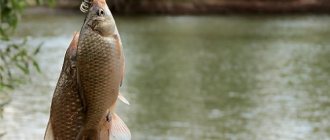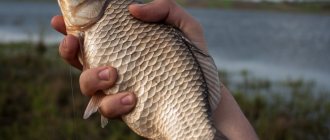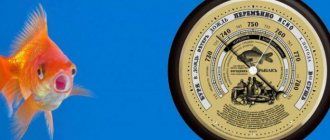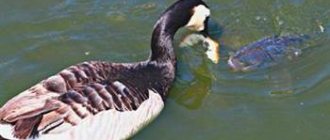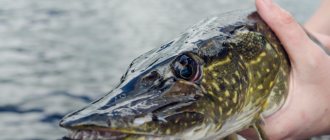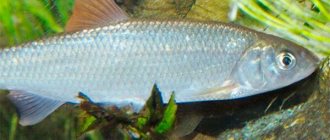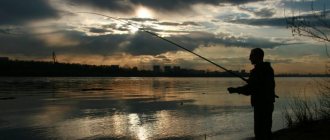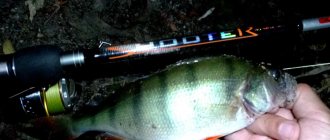I am sure that everyone has heard more than once from other fishermen, when asked: “What did you catch?”, the answer is: “It didn’t bite, the wind is north.” Either it was southern or northwestern, or it wasn’t there at all and there was no coolness, it was just “cool”, at least we had a good time. I think most fishermen have thought about how the direction and strength of the wind influence the migration and concentration of fish in certain places in a river or small body of water and, as a result, directly affect the success of fishing, nutrition and the overall bite rate of fish. Having spent some time searching and collecting information regarding influence of wind on fishing success, as well as adding my observations, I decided to share this information with you. And so, in this article I will consider several points that can, should or definitely affect the fish bite at a certain direction and wind strength, namely:
- wind direction relative to the location of the reservoir;
- the place where fish are concentrated during a particular wind direction and strength;
- permanent residence in continuous wind;
- influence on nutrition during windy conditions.
Who knew that wind always blows from areas of high pressure to areas of low pressure? This information is the quintessence of all knowledge and everything that we need to understand about the wind and fish bite, because it tells us about changes in atmospheric pressure when the wind direction changes and about its stable indicators (no matter increased or decreased) when the wind direction does not change a few days! This is one of the reasons when some fishermen catch perfectly in the north wind and say that they did not notice the influence, while others return from fishing with nothing.
Perhaps we should start by listing the well-known, time-tested and experience-tested causes and influences of wind on fish bite by our fathers and grandfathers, and then list more modern observations known to science. Probably the very first and universally known sign, confirmed repeatedly by experienced fishermen from all regions, countries and continents, is the poor bite of fish in northern and eastern winds.
Perhaps not, it’s worth starting with something else. Guys, Friends! If you really want to go fishing and it’s impossible to think about anything - go ahead, take your gear, call your friends, brew a thermos, get in the car and go, to hell with this wind or the fishing forecast and their impact on the bite! There is fish, well, it can’t help but eat. It’s up to us to find its habitat in this or that weather and time of year.
Wind: what is it from a scientific point of view?
The earth's surface is heated unevenly by the Sun, causing a difference in atmospheric pressure. Warm, light layers of air rush into the atmosphere, and cold currents take their place. These constant movements of air masses are the wind.
Wind mass flows
For example, the air above the lake surface warms up worse than the coastline, so the pressure above the water is higher and below the land it is lower. A blood pressure difference forms, and a breeze begins to blow from the reservoir. At night the situation changes because the water retains heat longer. Warm air rises over the lake, and a cool breeze blows from the shore.
Why does the wind blow
Wind is one of the most fickle phenomena of nature. Air masses are constantly in motion, differing in direction and strength, depending on the season, time of day, and terrain. Meteorologists define wind speed (m/s), note as:
- calm;
- strong or weak;
- moderate or gusty (squally);
- stable or changeable;
- long-term or short-term.
The greater the difference between the high and low blood pressure zones, the stronger the air flow. When considering it as an influencing factor on fish bite, the main parameters are taken into account, plus the local characteristics of the region.
Why does fish bite depend on the strength of the wind?
The wind drives the wave, and its magnitude has both positive and negative effects on the water area and its inhabitants.
Not every wind blows into the sails of fishing success.
A strong wind quickly saturates the water with oxygen, mixing the layers, while at the same time a strong wave scares the fish. She hides in the depths and does not surface for a long time, without experiencing a lack of oxygen. With the help of the wind, it penetrates to a depth of 1.5 - 2 meters, below is the thermocline zone, so they look for fish within these limits.
Important! Going out onto the water surface when the wind force is more than 12 m/s is dangerous and useless; the fish do not bite during this period.
Gusts of wind interfere with spot feeding and casting of gear. They usually bring bad weather: sudden changes in atmospheric pressure, rain, hail or snow. All these factors negatively affect fishing.
On a cloudless sunny day and no wind, even at sufficient depth the fish bite poorly. She is frightened by strong illumination, due to the transparency of the water, and unfavorable heating (chance: try a feeder or spinning rod with a spoon or wobbler). Complete calm will delight fishermen in the evening, at night, and at dawn. Carp species of fish are excellently caught - crucian carp, carp, carp and others.
Small ripples from a light breeze, blocking the fish’s external view, encourage a bite even on a float rod.
Small ripples from a light breeze are always a plus when fish bite
Air currents that raise a moderate wave drive a lot of food toward the shore for peaceful species, which in turn attract predators. These are insects, plant seeds, worms or larvae washed up from the shore by waves. For this reason, the bite on the leeward shore is always better.
It is good to catch perch, asp or pike using a spinner spoon and a spinner in the wave. However, fluff, pollen, leaves, and other debris on the water surface, washed ashore by waves, make fishing difficult.
The wind is strong and gusty and deposits debris on the water surface - this does not directly affect the fish bite, but it interferes with the fisherman
In the heat, strong air movement refreshes the water, so the surf shore is considered an excellent fishing spot. At the same time, it is difficult to control gear, especially in a side wind, so fishermen use bottom fishing methods. On the border strip of muddy and clear water, crucian carp and bream bite well on a float rod.
Wind factors
Direction
Among the factors influencing the behavior and bite of fish, we first note the wind direction. This is what is decisive in determining what air masses will bring with them: heat or cold, dryness or humidity.
In relation to most of the territory of Russia, it is known that northern winds bring cold temperatures, which for most underwater inhabitants, like other inhabitants of the planet, leads to stress and has a bad effect on their activity.
The southern direction of movement of air masses leads to warming and increased dryness of the air, and therefore to warming up of water and a decrease in its level due to excess evaporation. In summer, this effect on water bodies, and even under the condition of prolonged heat, leads to the formation of thermoclines - the stratification of the water column into areas with different temperatures. At the same time, the fish can concentrate in the coolest areas and practically not feed, what a bite!
Western winds, on the contrary, often bring humid air to us, which leads to rain and renewal of the level and chemical composition of water. Most often, the western and northwestern wind after hot weather brings a fresh stream into the reservoir, and the fish bite resumes. Moreover, this applies equally to pond carp, river bream, and predatory pike.
With easterly and southeasterly winds, dry weather prevails in the territories of Central Russia and Western Siberia, and the temperature is determined by the season of the year. In this case, the fish bite most often decreases slightly.
For Eastern Siberia, on the contrary, this air direction means the arrival of moist air masses from the Pacific Ocean. The influence of this wind on the fish bite is the same as that of the flows from the Baltic on the underwater inhabitants of European Russia; it is generally favorable.
The fish bite well immediately after a change in the wind, bringing with it changes in the weather:
- the north wind is favorable after prolonged heat;
- southern - after prolonged cold and dampness.
Wind strength and gusts
The best wind is not strong, its speed should not exceed 10 meters per second, and it should blow evenly, without gusts. High levels of wind flow cause strong disturbance of the water, which negatively affects underwater inhabitants, and the fish do not bite.
However, at morning and evening dawns, it is preferable to catch fish in complete calm. It is in this weather that crucian carp, carp and perch bite best. For river fish, this factor plays a lesser role due to the constant movement of water masses.
Gusty winds are most often combined with heavy rain and foretell the worst bite. Not only people don't like unstable weather, but fish don't like it either. And modern carbon fishing rods are even capable of attracting lightning, which can be deadly.
Duration of winds
Long-term movement of air masses most often means stabilization of temperature and pressure, which ultimately leads to an increase in fishing activity. At the same time, on the contrary, a long calm reduces the likelihood of bites, and for fishing in such weather it is better to choose reservoirs with a current.
In which wind direction does the fish bite better?
A warm front has low blood pressure, so cold layers move towards it. This is how the wind direction is formed. What it will be like on the day of fishing is not indifferent to fishermen, because it affects the bite.
Wind direction matters a lot for fishing
Air currents moving against the flow of the river help to catch large specimens. More often they are found in creeks or bays. If the wind blows with the current, the fish sinks to the bottom. Fishing is excellent with a float rod, because the wave keeps the bait in constant motion.
The wind from the shore is loved by chub, ide, dace, asp, and bleak, as they feed on insects, caterpillars, and larvae blown from coastal vegetation. At such moments, experienced fishermen re-equip their gear. It becomes possible to fish with a fishing rod even without a sinker at a depth of 15–30 cm. The best fishing place is coastal bushes.
Strong winds from the shore allow you to catch fish that feed on insects
Observations by fishermen have shown that the western, southwestern, and northwestern wind directions have a favorable effect on the number of bites. The east wind is not always good for fishing and not everything is so optimistic. However, if the southern wind, which has dominated the hot summer for a long time, changes to at least an eastern one, then the bite will intensify. When the water temperature in the upper layers drops, even predators go hunting.
Important! When the wind direction changes, the fish stops biting. Stable weather: pressure, temperature and wind, regardless of direction, restore her appetite.
Wind is a harbinger of anticyclones and cyclones and a determining weather factor. He blew from the east - a change is coming. A cold front is moving to the northeast and north, a cyclone is approaching - the fish are “straining”. True, crucian carp, tench, and perch bite for some time after the wind changes.
Cyclone and anticyclone
All air currents from the western direction, especially with moderate strength, have a positive effect on the catch, but in a strong gusty wind there are no bites, any gusty wind is bad for fishing.
A light breeze from the south indicates the passage of an anticyclone. It is manifested by warming, dry air. In the evening and morning, before the heat sets in, the fish are active and bite well. Prolonged calm in closed reservoirs is not conducive to fishing and leads to the appearance of a thermocline. During this period, it is better to fish in the current.
Rainy weather is brought by the western wind. A light drizzle or short rain helps fishing. It saturates the upper layers of the reservoir with oxygen, which attracts fish. All species bite well, and this weather is ideal for pike fishing.
West wind with warm rain is optimal for fishing in spring, autumn and summer
Gusty winds, especially at sunset, foreshadow bad weather. More often it is accompanied by heavy rain, thunderstorms or hail. The fish don't bite.
Important! The optimal wind for fishing is a steady southwest, the best speed is ripples on the water. In squalls, constant bad weather, when the weather changes, it is better to stay at home.
In what direction and strength of wind does the fish bite well and poorly?
Change in bite depending on the season
Fish actively bite during such seasons under the following circumstances:
- In the summer, especially in June, white bream, grass carp, crucian carp, asp, roach and ide are very actively biting.
- In spring, bream, perch and ruff are well caught.
- In the autumn, you should catch burbot, tench, pike perch and pike.
- In winter you can try catching small pike, roach and pike perch.
Deterioration in biting occurs under the following seasonal circumstances:
Since the “excess” water on the leeward shore has nowhere to go, a called a compensation current forms It is this current that equalizes the temperature and oxygen content in depth in a stagnant body of water. Its speed depends on the size and depth of the reservoir, as well as on the speed and direction of the drift current, and in the coastal zone it can be very significant. (This current carries unwary swimmers out to sea.)
Hello, dear fishermen of the Fishing School! The article presented below is professional and is the result of many years of fishing practice by Valery Fedorov.
Tips for fisherman: How to catch pike with mugs in summer - What to choose for fishing
Indeed, all more or less thinking fishermen made their analogies of the relationship between bite and the strength and direction of the wind. The work was written by Valery for feeder fishing, but we think that spinners and floaters can also take note of a lot, so links will be in all classes of the Fishing School.
author Valery Fedorov
Many copies have been broken on this topic. Some say “the biting stops”, others say “the biting begins”. Everything comes into play - temperature, oxygen, pressure, coupled with atmospheric electricity and sunspots. It is clear that since the wind affects the dynamics of the reservoir, it somehow affects the behavior of the fish. Let's figure it out.
If the cold (usually northerly) wind is more or less clear - by mixing the water, it can really cool the reservoir relatively quickly and noticeably. Without fear of making a mistake, we can assume that heat-loving fish species will need some time to adapt. (We, too, are not immediately drawn into a sharp cold snap). Consequently, the bite may worsen for some time. But with other winds nothing is clear. The bite may change for no apparent reason. Or maybe it won't change.
Where do we fish in windy weather? (By “windy weather” we mean a wind with a force of 4 on the Beaufort scale). That's right, on the windward shore, preferably with trees behind you. Everyone advises this. We feel comfortable here. The wind helps to cast the tackle and drives the wave from us to the opposite shore. Wave! How the surf lashes there! Some masochist is laying out gear in front of us. What is he going to do?
Let us understand: the wind drives not only the waves, but also the water itself to the opposite shore. This surface current is called drift. Its speed depends on the length of the reservoir in the direction of the wind, the speed of the wind and the duration of its action, the depth of the reservoir, the presence of islands and other factors.
Depending on these conditions, the speed of the drift current in reservoirs and lakes corresponding to their area can reach 7% of the wind speed. The water level (surge) on the leeward coast rises the more, the stronger the drift current. Until the flood (remember Pushkin’s “The Bronze Horseman”?). There is an empirical formula for determining the difference in water levels on the leeward and windward shores:
h = 452 x 10 (-9) xdx H (-1) xv (2) x cos (2) a;
where: h – difference in water levels (m);
d – wind acceleration length (m);
H – average depth of the reservoir (m);
v – wind speed at a height of 10 m (m/s);
a is the angle between the wind direction and the coastline.
Surges along reservoirs and lakes of similar area with a force 5-6 wind can reach 1 m. Take, for example, an average pond with a length of 1 km downwind and an average depth of 5 m. If the wind speed is about 10 m/s (normal fresh wind, which is felt by hand), then the difference in levels on opposite banks will be 9 mm.
Since the “excess” water on the leeward shore has nowhere to go, a called a compensation current forms It is this current that equalizes the temperature and oxygen content in depth in a stagnant body of water. Its speed depends on the size and depth of the reservoir, as well as on the speed and direction of the drift current, and in the coastal zone it can be very significant. (This current carries unwary swimmers out to sea.)
In our example, the speed of the drift current will be about 10-15 cm/s, and the compensation current will be an order of magnitude lower. This is not as little as it might seem. It is easy to calculate that from a linear meter of the shore the compensatory current will carry back up to 80 liters of water per minute.
What is important for us is that this current is saturated not only with oxygen, but also with fractions washed out by the surf . It is known that fish are more willing to go against the current. Therefore, the riding fish moves against the drift current to the windward shore, where there are almost no waves, and there is more food blown from the shore to the surface of the water by the wind. (That is, to us).
This is where many fishermen are convinced that they need to fish on the windward shore. But the feeder’s place at this time is on the opposite – leeward – shore, where the compensatory current collects bottom fish. That is, a masochist is not a masochist at all, but a feeder.
Near the shore, the strength of the compensation current depends not only on the strength and direction of the drift current, but also on the shape of the shore and bottom itself. For example, the deeper near the shore, the slower the current, as it carries large masses of water with it. The fish is closer to the shore.
If the coastal strip is too shallow, the compensatory current carries away a lot of sand and turbidity raised by the surf, and the fish stand further away. Another example is that the concave shape of the leeward coastline plays the role of a focusing lens, accumulating and enhancing the surge of water, and with it the compensatory current (Fig. 1). And, therefore, collecting fish in a narrow strip.
Tips for fisherman: How to catch bream on a fishing rod in summer - Features of choice
According to my observations, the optimal ratio of the length of the “lens” to its concavity is in the range of approximately 1/0.2-1/0.3. At the same time, depending on the strength of the wind, the best concentration for the feeder (and no other method of fishing against a noticeable wind is possible) is the concentration of the compensatory current if the length of the “lens” is within 40-50 meters, with its concavity of 10-15 meters.
In our example, from 50 meters of the shore, the “lens” will concentrate and send back up to 4 tons of water per minute, which, mixing with the deep layers, form a stream up to 10 meters wide, enriched with oxygen and food. The maximum concentration of the flow occurs at a distance of about 30 meters from the shore. (Then the flow dissipates.) If it's the right depth, that's what you need.
Considering that you need to “punch” the wind with a force of 4-5, throwing the equipment further than 30-35 m is problematic. In this case, starting feeding may not be necessary. The fish will still be where it needs to be. Even if the flow, for various reasons (the drift current is smaller or at an angle to the shore, the shape of the “lens” is far from ideal) will be half as weak, then 2 tons of water per minute concentrated into the flow is impressive.
If the “lens” is shorter, then the flow will be weaker. If the “lens” is longer or its concavity is smaller, then the flow will be concentrated at a greater distance, and within our reach it will be even “smeared out”. If the concavity of the “lens” is greater and the bottom is deep enough, then the fish can stand closer to the shore.
If there are small shallows or even islands near the leeward coast, then the concentration of the compensation current does not need to be “calculated”. The current is focused in channels between islands and shallows (Fig. 2).
As we see, there are many possible options. The compensatory current also “works” in a wide flat river if the wind blows across the river and the channel is far enough from the leeward bank. Moreover, it “works” in river bends (Fig. 3), when the wind blows against the current and the size of the bend is sufficient for a surge of water. In this case, the effect is weaker, but something is better than nothing.
In light of the above, the fishing superstition becomes clear: “with a change in wind direction, the bite changes.” Of course it changes. Still would! When choosing a fishing location, the general approach is this: the more the shape of the shore and coastal strip contributes to the surge of water, the stronger the compensatory current will be in this place.
First of all, it is necessary to study the shape of the coast, compare it with the strength and direction of the wind, determine the approximate direction of concentration of the compensation current, etc. Then determine the fishing point and go ahead. It's a matter of practice. The main thing is not to hide from the wind, then the sunspots will be on our side!
- Chafer;
- grasshopper;
- red worms;
- fry;
How does wind affect water temperature and fish bite?
Freshwater fish are divided into heat-loving fish (crucian carp, tench, carp, grass carp), universal fish (perch, pike perch, ruffe), and those preferring cold water (pike, trout, burbot, omul, grayling). Water temperature has a significant impact on their behavior, and the wind takes an active part in regulating it, mixing layers, cooling or warming the air.
Important! Not all fish react to the wind the same way. Cold currents negatively affect the bite of heat-loving species, and some predators are activated at this time.
Fish have a certain range of body temperature, a decrease in which causes them discomfort, even into suspended animation. The increase has a destructive effect on the body's cells and it falls into stupor; if it does not cool down in time, it will die. When there are sudden changes, she experiences shock and does not have time to adapt. Each type has its own meanings. Based on the temperature regime, the fish bite is calculated relative to the air temperature, time of day and weather conditions.
When to catch which fish
The cold northern wind cools the water, heated by the summer heat, and the warm southern wind, after a long period of coolness, warms the upper layers of the reservoir.
Conclusion! The wind is directly involved in the life of fish, saturating the water with oxygen and adjusting the temperature, activating not only appetite, but also life.
Water level and transparency
When fishing for bream in river conditions, its activity is affected by the water level. When a river overflows its banks as a result of spring snowmelt or heavy autumn rains, you cannot count on a good fish bite. Fishing will be more successful if the level does not change for a long time.
Spring floods and heavy rains can significantly reduce water transparency, which will negatively affect the activity of bream. A strong current carries dirt and debris that clogs the gills. It becomes difficult for the fish to breathe, and it presses against the shore, where the flow is weaker. After such natural phenomena, the bite usually begins no earlier than 5–7 days later.
In late autumn and winter, the water in lakes can be very clear, which makes bream extremely cautious. In such conditions, you can count on good fishing only if you use thin lines (within reasonable limits).
The relationship between wind, atmospheric pressure and fish appetite
The movement of air flows is directly related to changes in blood pressure. As a result of changes, significant changes occur in nature, including changes in oxygen levels and hydrostatic pressure of water. The orientation and feeding behavior of fish depend on these indicators.
An anticyclone is accompanied by increased atmospheric pressure, while a cyclone brings about a decrease in atmospheric pressure. If a constant wind blows, no matter what direction or strength, the blood pressure is stable. The fish manages to adapt to these conditions and bites actively. Any changes in the wind are accompanied by pressure changes and a lack of bites.
Pike bite aggressively in a westerly wind, especially good if there is a light drizzle on the water
Fishermen have noticed that high blood pressure increases the appetite of peaceful species. Low blood pressure has a depressing effect on them, making them easy prey for predators. This period is the best for fishing for pike, asp, pike perch, and perch.
The influence of pressure on the bite (activity) of fish:
Fishing secret
An experienced fisherman can always determine the weather in the next few hours using the wind in a simple way.
It is known that if you turn your back to the wind, the center of low pressure will always be in front and slightly to the left, and the center of high pressure will be directly diagonally behind and slightly to the right.
If the sky ahead on the left is darkening and approaching clouds are visible, then bad weather and cold weather (cyclone) is approaching; if the sky is clear and cloudless, there will be good weather (anticyclone).
In what wind does fish bite well in summer - and why is there such a dependence?
Waves generated by the wind form a surface current on stagnant bodies of water. It moves the water mass to the leeward shore, bringing with it additional food for surface fish. This is also where the maximum oxygen saturation of water is located. With strong wind currents in this zone, even the water level increases. The waves rolling back form a lower current, which carries invertebrates washed up from the shore along the bottom, delighting bottom-dwelling fish.
At shallow depths of a lake or pond, a favorable fishing spot with a hard bottom. Fish rarely enter creeks with a muddy bottom, or into dense thickets of water lilies, reeds, and algae. Their death and decomposition leads to a lack of oxygen in the water column. and strong winds lift sediments that are toxic to fish from the bottom. It is better to stop where the reeds grow. It prefers hard ground.
A hard bottom is good for fishing in strong winds.
A light breeze, even on a sunny day, creates a “motley” background in shallow water. It allows predators to get close to the prey, so not only roach and bleak, but also pike take the bait. She is especially active on cloudy, cool days.
On rivers there is no problem of choosing a place - all the fish feed near the surface, although fishing here is much more difficult. The current does not allow harmful impurities to accumulate at the bottom; the fish finds enough food anywhere throughout the hot period.
Excellent fishing awaits in the heat, when air masses drive the waves back. On a sunny day, large fish are concentrated in deep depressions and pressed against the shady side of the shore. Here, with a short fishing rod, you can catch roach, silver bream, chub, and bream. Suitable for baiting ide.
True, the wind slows down the progress of the equipment, increasing the bite time, so it is better to take a thicker line and a more compact bait: one grain of wheat or maggot, or another larva from a given river.
In which winds does the fish bite poorly, and in which winds does it bite well:
Activity calendar
Throughout the year, the feeding activity of bream changes several times. If in some months he feeds intensively and willingly pecks at the baits offered to him, then in others it can be quite difficult to provoke him to bite.
March
In the first half of March, there is still ice in most of Russia. The amount of oxygen dissolved in water is low, which negatively affects the activity of bream. During this period, you can only count on a stable bite on rivers. In lakes and reservoirs, fish still behave passively.
In the second half of March the situation changes dramatically. Towards the end of the month, daytime temperatures remain above zero, which is why the snow begins to rapidly melt. Fresh water entering under the ice improves the oxygen regime, thereby increasing the activity of the fish.
By the end of March, bream rises from their wintering pits and begins to move around the water area in search of a better food supply. Fishing can be very successful at this time. For fishing, you should use a search strategy, which involves constantly moving and drilling a large number of holes.
April
With the arrival of April, the reservoirs of the southern regions are freed from ice cover and it becomes possible to catch bream using summer types of gear. The bite begins two weeks after the ice melts, when the peak of the flood has passed. This period falls in the second half of the month. The fish prefers to stand:
- in the coastal zone at a depth of up to 3 m;
- in shallow river bays;
- in eriks and oxbows.
In the middle zone, bream continues to be successfully caught from the ice. Fishing for winter gear lasts until the 10th–15th. Then there comes a break in the bite. The fish resume their activity at the end of the month and begin to be caught on summer fishing rods.
In the northern regions of the country, water bodies are free of ice only by the end of April. Fishing with summer gear here begins no earlier than mid-May.
May
This month, the bream begins a period of feeding. The fish tries to recover faster after winter and exhibits increased feeding activity. At this time, summer gear is used to catch it:
- a rod equipped with a side nod and a jig;
- float rod with blind equipment;
- match tackle;
- feeder;
- donku;
- "rubber band".
In the middle or end of May (depending on the region), bream begins to spawn. During spawning, he ignores the baits offered to him and does not fall for amateur gear.
June
In June, bream activity is also at a high level. Having spawned, the fish begins to feed intensively, recovering from spawning. Throughout the month, she willingly bites, preferring baits of plant origin:
- corn;
- semolina dough;
- scalded oatmeal;
- bread crumb;
- pellets;
- boilies.
A lull in the bream bite is often observed at the end of June, when the water temperature rises significantly. The decrease in summer activity is especially noticeable in lakes, where the oxygen regime is worse than in rivers.
July
In July, the water begins to bloom, and its temperature approaches values that are uncomfortable for fish. You can’t count on a good bream bite during this period.
Anglers whose boats are equipped with an echo sounder often observe a picture in the middle of summer when schools of bream rise to the middle layers of the water and stand motionless. Even a bait thrown into the center of a fish concentration does not arouse its interest.
Bream fishing in July is successful only in the dark. At night, the fish swims to shallow areas and actively feeds until dawn. After sunrise, only small undergrowth can be seen.
August
In August, water temperatures begin to drop and fish activity increases. Bream still continues to be caught in the dark, but a good bite is also possible in the morning and evening hours.
By the end of August, the night activity of fish noticeably decreases. The bream gradually begins to switch to a daytime diet.
September
In September, the fish feed intensively, accumulating fat reserves before winter. With the onset of autumn, bream moves further from the shore, so match and feeder gear is used to catch it. The following nozzles work best:
- bloodworm;
- muckworm;
- maggot.
This month, bream bites at night are extremely rare. By the end of September the water becomes clearer and the fish begin to behave capriciously. For successful fishing you will need delicate equipment with thin leads and small hooks.
October
With the arrival of October, bream form large schools and begin to migrate closer to the wintering holes. It continues to be caught well with various fishing gear in deep places, but its activity is significantly lower than in August and the first half of September.
In order to quickly accumulate fat reserves, in October bream often switches to feeding on young fish. At this time, it is possible to catch him using spinning baits:
- small twisters and vibrotails;
- jig-class oscillating spoons;
- silicone imitation crayfish and worms.
The end of October is not the best period for catching bream. When the water temperature drops sharply, the fish behaves passively and reacts poorly to bait offered to it.
November
In November, breamers rarely boast of a rich catch. The fish stand in the wintering pits and do not pay attention to the bait. The fishing situation does not change throughout the month.
December
December is a favorite time for fans of fishing for bream using winter gear. This month, strong ice is being installed on reservoirs in the middle zone and northern regions, allowing access to the most promising places.
During the first 10–15 days after the ice cover forms, the fish get used to the new conditions and do not bite. The second half of December is the best time to catch bream from ice. It actively feeds and is successfully caught with various types of winter gear in places with a depth of 6–10 m.
January
Until mid-January, a good bream bite continues on rivers and lakes. In the second half of the month, the activity of fish in stagnant reservoirs noticeably decreases, which is associated with a deficiency of oxygen dissolved in the water.
Towards the end of January, you can only count on a good catch in running water. To achieve regular bites on closed lakes, the holes need to be fed for several days.
February
In February, bream behaves very passively. While on rivers you can still count on a good bite from this fish, in reservoirs with no current, fishing is rarely effective. The lack of bite continues until active ice melting begins.
How does the wind affect the bite in autumn?
At the beginning of autumn, the fish are actively biting, they sense the cold weather and the approach of winter, so they try to feed themselves for future use. A comfortable fishing period begins for the fisherman. No heat and no blood-sucking insects. During this period, the direction of the wind is not so important, the main thing is that there are no squalls. A good appetite was noticed in a western direction; even moderate flows from the east will not spoil the impression.
East, west and east-west winds in autumn are good for fishing
Things are worse in the second half of autumn, when northerly winds with bad weather prevail, and the water becomes very cold. The fish becomes lethargic. The main fish species are preparing for bed. The fat intake of asp and chub decreases. Crucian carp, carp, and bream go into suspended animation.
Small fish do not bite at all in windy weather. In early October, they hide from strong winds in coastal holes or channel edges; here the water has not yet cooled down as much as in other parts of the reservoir.
Autumn fishing is often accompanied by strong winds
Already at the end of October, white fish concentrate near the wintering pits and switch to the winter feeding regime. They are caught using spinning, trolling, and feeder gear. Donka without a feeder is an option for late autumn, when fish react poorly to bait.
The best weather for pike fishing
Pike is an indigenous inhabitant of fresh water bodies, which is widespread in Europe, Asia, and North America. An adult reaches one and a half meters in length and weighs more than 5 kg. In some cases, fishermen mentioned giants exceeding 20 and 25 kg. The average size of the “toothy” fish, which readily falls for the bait, rarely reaches such values; usually the catch contains individuals from 1 to 1.5 kg. Sexual maturity of the predator occurs in the fourth year of life. The fry feeds on small worms, invertebrates, and other underwater creatures. As young pike grow older, they switch to large prey - small fish, tadpoles, frogs. Seasoned beauties do not disdain waterfowl rats, as well as birds.
How does the wind affect the catch in the spring - in what direction and strength is success accompanied?
The most favorable time is when the wind does not have much influence on the bite. The seasonal transition is not taken into account when there are sharp changes in blood pressure, snowstorms, giving way to short-term thaws. It’s not just fish here, even fishermen prefer to sit at home. Since the end of March, southern directions have prevailed, with:
- air temperature rises;
- atmospheric pressure increases;
- the ice crust is breaking up, especially near the coastline;
- snow is actively melting;
- The turbidity of water near the coast increases.
Floods carry abundant food for fish into reservoirs. Air currents help saturate the water with oxygen. All types of fish, hungry during the winter, rise to the surface and grab everything. In spring, many of them prepare for spawning, so their zhor increases. Successful fishing awaits in the coastal shallows.
Important! Spring ice is very fragile. Do not risk your health and life by going out to him in the wrong place.
Wind work
Let's consider the work of the wind on a reservoir, what happens at this time to the water and its inhabitants.
The blowing wind moves the water mass from the windward coast to the leeward one. Along with this, the following phenomena occur:
- saturation of water with oxygen;
- blowing and washing away insects from the windward shore;
- erosion of the leeward shore exposing underwater microorganisms;
- formation of an underwater reverse current.
The fish has adapted well to this influence of the wind, and often chooses sites with the highest concentration of food or oxygen. The skill of the fisherman lies in identifying the most likely place to catch a fish.
Why, for example, are the edges considered the most catchy places in a reservoir? Yes, all because food particles, carried by wind-driven water currents, literally rest against the dumps, and descend along them to the edges.
In connection with the above, we can draw the following conclusions: 1. If the wind blows from a steep bank, you should position yourself on it, because the treasured edge is located close to it. At the same time, it is better to fish with float gear. It’s also convenient to fish from the leeward side, because a lot of food particles come here too.
2. If the windward side is a gently sloping shore or beach, then food particles will be carried to a distant edge, which can sometimes only be reached with long-range gear. On the leeward cliff you can fish almost at the very edge of the water, here there is active coastal erosion of the soil and exposure of underwater worms.
3.Curves of the coastline, especially leeward coves, will be especially interesting for fishing in windy weather. Here, a large amount of food is concentrated in peculiar lagoons.
4. Almost the same as in coves, fish are concentrated in the channels between islands or underwater navels. Such elevations also trap particles of fish food near them.
5. The wind blows insects from bushes, grass and other vegetation into the water. This is successfully used by some types of fish: ide, chub, bleak, sabrefish. And the fisherman should know this feature and catch these types of fish from the windward shore.
Of course, talking about food particles concentrating fish at certain points is true for peaceful fish. But predators also know or instinctively follow this law when searching for the objects of their hunt.
What wind is optimal for fishing in winter?
Winter blizzard
In winter, air currents do not directly affect the water due to the ice crust, but atmospheric pressure still affects the bite. In winter, strong north or east winds are often accompanied by blizzards, creating snow drifts or exposing the slippery surface of ice.
Fishing is more difficult in winter than in warm weather
The approaching anticyclone portends increased frost. Stable low t – 20 – 30°C for a long period predicts deaf winter. These factors not only complicate fishing, but also deactivate the bite.
Predators become cautious, even the voracious perch becomes quiet. Avid fishermen, who don’t mind the vicissitudes of the weather, constantly experiment using special baits and tackle.
The only freshwater fish that is little affected by bad weather and severe frost is burbot. True, it spawns in winter; fishing may be prohibited in some regions.
A stable calm, even on a clear day or cloudy weather, promises an excellent catch. Breaths from the south and its intermediate directions bring warming and trigger the bite. The higher the thermometer rises, the more successful the catch. In light frost with a slight wind, all-weather roach or perch, pike perch, and pike are excellently caught.
Of course, successful biting depends on the wind. Its direction and strength play a significant role. To ensure that fishing leaves a pleasant impression, take into account the factors associated with the wind.
